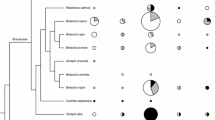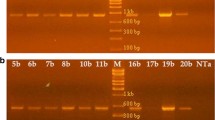Abstract
In several studies plant lectins have shown promise as transgenic resistance factors against various insect pests. We have here shown that pea seed lectin is a potential candidate for use against pollen beetle, a serious pest of Brassica oilseeds. In feeding assays where pollen beetle larvae were fed oilseed rape anthers soaked in a 1% solution of pea lectin there was a reduction in survival of 84% compared to larvae on control treatment and the weight of surviving larvae was reduced by 79%. When a 10% solution of pea lectin was used all larvae were dead after 4 days of testing. To further evaluate the potential use of pea lectin, transgenic plants of oilseed rape (Brassica napus cv. Westar) were produced in which the pea lectin gene under control of the pollen-specific promoter Sta44-4 was introduced. In 11 out of 20 tested plants of the T0-generation there was a significant reduction in larval weight, which ranged up to 46% compared to the control. A small but significant reduction in larval survival rate was also observed. In the T2-generation significant weight reductions, with a maximum of 32%, were obtained in 10 out of 33 comparisons between transgenic plants and their controls. Pea lectin concentrations in anthers of transgenic T2-plants ranged up to 1.5% of total soluble protein. There was a negative correlation between lectin concentration and larval growth. Plants from test groups with significant differences in larval weights had a significantly higher mean pea lectin concentration, 0.64% compared to 0.15% for plants from test groups without effect on larval weight. These results support the conclusion that pea lectin is a promising resistance factor for use in Brassica oilseeds against pollen beetles.
Similar content being viewed by others
References
Åhman I (1993) A search for resistance to insects in spring oilseed rape. IOBC/WPRS Bull 16: 36–46.
Allsopp PG and McGhie TK (1996) Snowdrop and wheatgerm lectins and avidin as antimetabolites for the control of sugarcane whitegrubs. Entomol Exp Appl 80: 409–414.
Anonymous (2001) Méligèthes du colza. Bonnes pratiques et protection raisonnée plus que jamais d'actualité. Phytoma 536: 10–12.
Beck E, Ludwig G, Auerswald EA, Reiss B and Schaller H (1982) Nucleotide sequence and exact localization of the neomycin phosphotransferase gene from transposon Tn5. Gene 19: 327–336.
Becker D, Kemper E, Schell J and Masterson R (1992) New plant binary vectors with selectable markers located proximal to the left T-DNA border. Plant Mol Biol 20: 1195–1197.
Begbie R and King TP (1985) The interaction of dietary lectin with porcine small intestine and the production of lectinspecific antibodies. In: Bog-Hansen TC and Breborowicz J (eds), Lectins. Vol. 4 (pp. 15–27) Walter de Gruyter and Co, Berlin, Germany.
Boulter D, Edwards GA, Gatehouse AMR, Gatehouse JA and Hilder VA (1990) Additive protective effects of different plant-derived insect resistance genes in transgenic tobacco plants. Crop Prot 9: 351–354.
Bowles DJ, Marcus SE, Pappin DJC, Findlay JBC, Eliopoulos E, Maycox PR et al. (1986) Posttranslational processing of concanavalin A precursors in jackbean cotyledons. J Cell Biol 102: 1284–1297.
Edwards GA, Hepher A, Clerk SP and Boulter D (1991) Pea lectin is correctly processed, stable and active in leaves of transgenic potato plants. Plant Mol Biol 17: 89–100.
Ekbom B and Borg A (1996) Pollen beetle (Meligethes aeneus) oviposition and feeding preference on different host plant species. Entomol Exp Appl 78: 291–299.
Ekbom B and Kuusk A-K (2001) Rapsbaggar och resistens mot pyretroider. Växtskyddsnotiser 65: 39–42.
Elden TC (2000) Effects of proteinase inhibitors and plant lectins on the adult alfalfa weevil (Coleoptera: Curculionidae). J Entomol Sci 35: 62–69.
Foissac X, Loc NT, Christou P, Gatehouse AMR and Gatehouse JA (2000) Resistance to green leafhopper (Nephotettix virescens) and brown planthopper (Nilaparvata lugens) in transgenic rice expressing snowdrop lectin (Galanthus nivalis agglutinin; GNA). J Insect Physiol 46: 573–583.
Fritzsche R (1957) Zur Biologie und Ökologie der Rapsschädlinge aus der Gattung Meligethes. Z Angew Entomol 40: 222–280.
Gatehouse AMR, Davison GM, Stewart JN, Gatehouse LN, Kumar A, Geoghegan IE et al. (1999) Concanavalin A inhibits development of tomato moth (Lacanobia oleracea) and peach-potato aphid (Myzus persicae) when expressed in transgenic potato plants. Mol Breeding 5: 153–165.
Graham J, Gordon SC and McNicol RJ (1997) The effect of the CpTi gene in strawberry against attack by vine weevil (Otiorhynchus sulcatus F.; Coleoptera: Curculionidae). Ann Appl Biol 131: 133–139.
Grant G (1989) Anti-nutritional effects of dietary lectins. Aspects Appl Biol 19: 51–74.
Higgins TJV, Chandler PM, Zurawski G, Button SC and Spencer D (1983) The biosynthesis and primary structure of pea seed lectin. J Biol Chem 258: 9544–9549.
Hilder VA and Boulter D (1999) Genetic engineering of crop plants for insect resistance - a critical review. Crop Prot 18: 177–191.
Hilder VA, Powell KS, Gatehouse AMR, Gatehouse JA, Gatehouse LN, Shi Y et al. (1995) Expression of snowdrop lectin in transgenic tobacco plants results in added protection against aphids. Transgenic Res 4: 18–25.
Hoedemaeker FJ, Richardson M, Diaz CL, de Pater BS and Kijne JW (1994) Pea (Pisum sativum L.) seed isolectins 1 and 2 and pea root lectin result from carboxypeptidase-like processing of a single gene product. Plant Mol Biol 24: 75–81.
Hokkanen HMT (1993) Overwintering survival and spring emergence in Meligethes aeneus: effects of body weight, crowding, and soil treatment with Beauveria bassiana. Entomol Exp Appl 67: 241–246.
Hong HP, Gerster JL, Datla RSS, Albani D, Scoles G, Keller W et al. (1997) The promoter of a Brassica napus polygalacturonase gene directs pollen expression of α-glucuronidase in transgenic Brassica plants. Plant Cell Rep 16: 373–378.
Leplé JC, Bonadé-Bottino M, Augustin S, Pilate G, Dumanois Lê Tân V, Delplanque A et al. (1995) Toxicity to Chrysomela tremulae (Coleoptera: Chrysomelidae) of transgenic poplars expressing a cysteine proteinase inhibitor. Mol Breeding 1: 319–328.
Loris R, Hamelryck T, Bouckaert J and Wyns L (1998) Legume lectin structure. Biochim Biophys Acta 1383: 9–36.
Maqbool SB, Riazuddin S, Loc NT, Gatehouse AMR, Gatehouse JA and Christou P (2001) Expression of multiple insecticidal genes confers broad resistance against a range of different rice pests. Mol Breeding 7: 85–93.
Moloney MM, Walker JM and Sharma KK (1989) High efficiency transformation of Brassica napus using Agrobacterium vectors. Plant Cell Rep 8: 238–242.
Nilsson C (1987) Yield losses in summer rape caused by pollen beetles (Meligethes spp.). Swed J Agr Res 17: 105–111.
Nilsson C (1988) The pollen beetle (Meligethes aeneus F.) in winter and spring rape at Alnarp 1976-1978. I. Migration and sex ratio. Växtskyddsnotiser 52: 134–138.
Perlak FJ, Stone TB, Muskopf YM, Petersen LJ, Parker GB, McPherson SA et al. (1993) Genetically improved potatoes: protection from damage by Colorado potato beetles. Plant Mol Biol 22: 313–321.
Prasthofer T, Phillips SR, Suddath FL and Engler JA (1989) Design, expression, and crystallization of recombinant lectin from garden pea (Pisum sativum). J Biol Chem 264: 6793–6796.
Richards E, Reichardt M and Rogers S (1994-2000) Preparation of genomic DNA from plant tissue. In: Ausubel FM, Brent R, Kingston RE, Moore DD, Seidman JG, Smith JA et al. (eds) Current Protocols in Molecular Biology. Vol. 1 (pp. 2.3.1–2.3.7) Wiley, New York, NY, USA.
Sambrook J, Fritsch EF and Maniatis T (1989) Molecular Cloning, A Laboratory Manual. 2nd edn, Cold Spring Harbor Laboratory Press, Cold Spring Harbor, NY, USA.
Schuler TH, Poppy GM, Kerry BR and Denholm I (1998) Insectresistant transgenic plants. Trends Biotechnol 16: 168–175.
Shade RE, Schroeder HE, Pueyo JJ, Tabe LM, Murdock LL, Higgins TJV et al. (1994) Transgenic pea seeds expressing the α-amylase inhibitor of the common bean are resistant to bruchid beetles. BioTechnology 12: 793–796.
Strosberg AD, Buffard D, Lauwereys M and Foriers A (1986) Legume lectins: a large family of homologous proteins. In: Liener, Sharon and Goldstein (eds), The Lectins: Properties, Functions, and Applications in Biology and Medicine (pp. 249–264) Academic Press, Orlando, FL, USA.
Tinjuangjun P, Loc NT, Gatehouse AMR, Gatehouse JA and Christou P (2000) Enhanced insect resistance in Thai rice varieties generated by particle bombardment. Mol Breeding 6: 391–399.
Walkerpeach CR and Velten J (1994) Agrobacterium-mediated gene transfer to plant cells: cointegrate and binary vector systems. In: Gelvin SB and Schilperoort RA (eds), Plant Molecular Biology Manual. 2nd edn (pp. B1: 1–19) Kluwer Academic Publishers, Dordrecht, Netherlands.
Williams IH and Free JB (1978) The feeding and mating behaviour of pollen beetles (Meligethes aeneus Fab.) and seed weevils (Ceutorynchus assimilis Payk.) on oil-seed rape (Brassica napus L.). J Agr Sci Camb 91: 453–459.
Author information
Authors and Affiliations
Rights and permissions
About this article
Cite this article
Melander, M., Åhman, I., Kamnert, I. et al. Pea Lectin Expressed Transgenically in Oilseed Rape Reduces Growth Rate of Pollen Beetle Larvae. Transgenic Res 12, 555–567 (2003). https://doi.org/10.1023/A:1025813526283
Issue Date:
DOI: https://doi.org/10.1023/A:1025813526283




